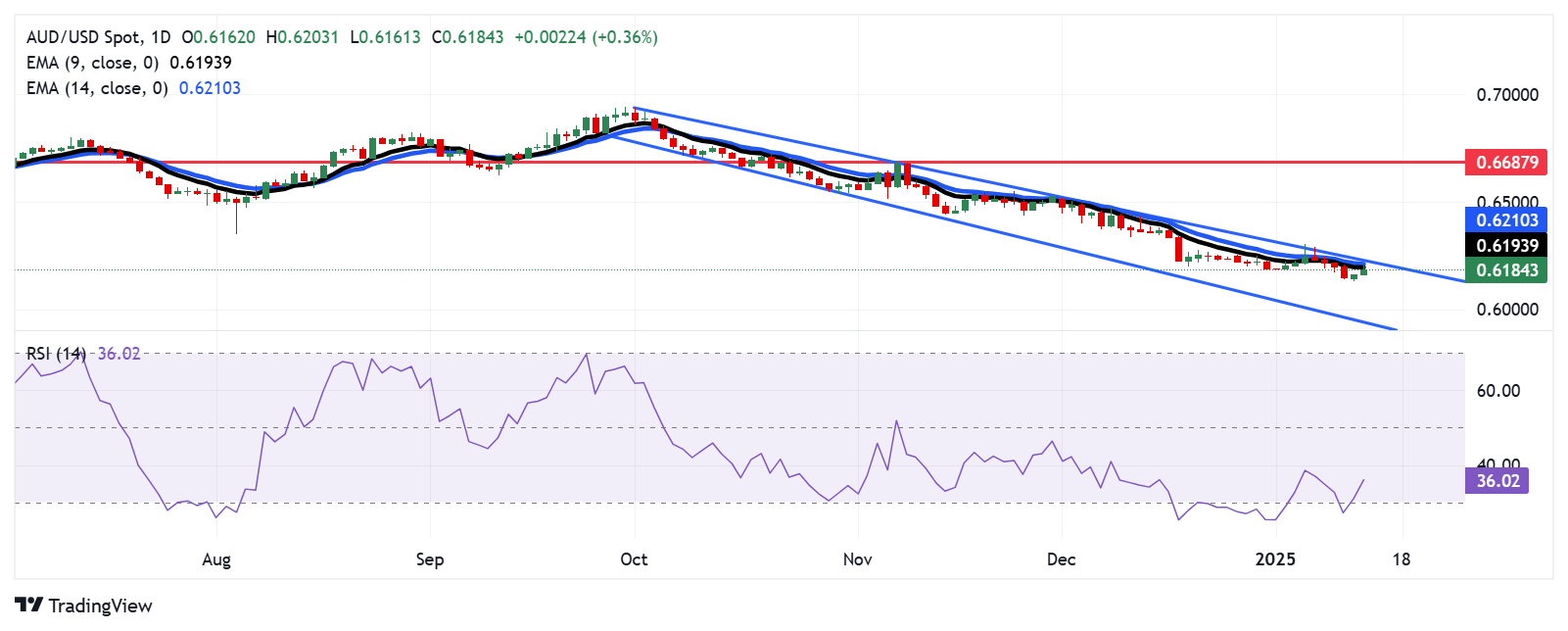- The Australian Dollar has rebounded from 0.6131, its lowest level since April 2020.
- The AUD receives support from strong commodity prices amid improved market sentiment.
- The US Dollar receives support from rising odds of the Fed maintaining rates in January.
The Australian Dollar (AUD) extends its gains against the US Dollar (USD) for a second consecutive day on Tuesday, rebounding from 0.6131, its lowest level since April 2020. The AUD/USD pair strengthened as the AUD benefitted from robust commodity prices.
US President-elect Donald Trump's economic team considers a gradual increase in import tariffs boosted investor confidence, supporting the risk-sensitive currencies like the AUD and contributing to the appreciation of the AUD/JPY pair.
The S&P/ASX 200 Index also increased by 0.48% to around 8,230 on Tuesday, snapping a three-day losing streak. Mining and energy stocks led the recovery, while Australian shares followed overnight gains on Wall Street, where investors shifted focus from megacap tech stocks to other sectors.
Traders analyzed data showing a second consecutive monthly drop in consumer confidence. Australia's Westpac Consumer Confidence Index fell by 0.7% to 92.1 points in January 2025, highlighting persistent pessimism among consumers.
The AUD/USD pair faces downward pressure as markets price in a 75% probability of a rate cut by the Reserve Bank of Australia (RBA) next month. Investors are expected to closely monitor Australian employment data, set to be released later this week, for additional clarity on the RBA's policy outlook.
The AUD also found some support from China's recent stimulus measures, given the close trading relationship between Australia and China, any changes in China's economic conditions could significantly influence Australian markets.
Australian Dollar could struggle due to hawkish sentiment surrounding Fed’s policy outlook
- The US Dollar Index (DXY), which measures the US Dollar’s performance against six major currencies, trades near 109.60, close to its highest level since November 2022. The USD gained strength following robust US labor market data for December, which is expected to support the US Federal Reserve’s (Fed) decision to maintain interest rates at current levels in January. The US Producer Price Index (PPI) for December will take center stage later on Tuesday.
- US labor market data fueled a rise in US Treasury yields, with the 2-year yield climbing to 4.42% and the 10-year yield reaching 4.80% as of Monday.
- Data from the US Bureau of Labor Statistics (BLS), released on Friday, reported that Nonfarm Payrolls (NFP) increased by 256K in December, significantly exceeding market expectations of 160K and surpassing the revised November figure of 212K (previously reported as 227K).
- Federal Reserve Board of Governors member Michelle Bowman added her voice to a chorus of Fed speakers last week as policymakers work double-duty to try and smooth over market reactions to a much tighter pace of rate cuts in 2025 than many market participants had previously anticipated.
- Kansas Fed President Jeffrey Schmid made headlines on Thursday, stating that most of the Federal Reserve's mandated targets have recently been achieved. Schmid emphasized the need to reduce the Fed's balance sheet, suggesting that interest rate policy is approaching its long-term equilibrium. He noted that any future rate cuts should be gradual and guided by economic data.
- On Monday, the China Foreign Exchange Committee (CFXC) pledged to support the Chinese Yuan during a meeting in Beijing on Monday, held under the guidance of the People’s Bank of China (PBOC). Separately, the PBOC and the State Administration of Foreign Exchange (SAFE), China’s FX regulator, announced an increase in the macro-prudential adjustment parameter for cross-border financing from 1.5 to 1.75, effective January 13, 2025.
- TD-MI Inflation Gauge climbed by 0.6% month-over-month in December, a significant acceleration from the 0.2% increase in November, reaching its highest level since December 2023. On an annual basis, the Inflation Gauge rose by 2.6%, down from the previous 2.9% increase.
- People's Bank of China (PBOC) Governor Pan Gongsheng stated on Monday that "interest rate and reserve requirement ratio (RRR) tools will be utilized to maintain ample liquidity." Gongsheng reaffirmed China's plans to increase the fiscal deficit and emphasized that China will continue to be a driving force for the global economy.
Technical Analysis: Australian Dollar advances to near nine-day EMA, 0.6200
The AUD/USD pair trades around 0.6190 on Tuesday, maintaining its bearish outlook as it remains within a descending channel on the daily chart. The 14-day Relative Strength Index (RSI) has climbed above the 30 level, indicating a recovery from oversold conditions.
The pair faces immediate resistance at the nine-day Exponential Moving Average (EMA) at 0.6193, followed by the 14-day EMA at 0.6210. A more significant resistance level lies near the upper boundary of the descending channel, around 0.6230.
On the downside, the AUD/USD pair may test support at the lower boundary of the descending channel, close to the 0.5940 level.
AUD/USD: Daily Chart
Australian Dollar PRICE Today
The table below shows the percentage change of Australian Dollar (AUD) against listed major currencies today. Australian Dollar was the strongest against the US Dollar.
| USD | EUR | GBP | JPY | CAD | AUD | NZD | CHF | |
|---|---|---|---|---|---|---|---|---|
| USD | -0.40% | -0.34% | -0.19% | -0.15% | -0.48% | -0.82% | -0.32% | |
| EUR | 0.40% | 0.07% | 0.21% | 0.26% | -0.08% | -0.42% | 0.08% | |
| GBP | 0.34% | -0.07% | 0.15% | 0.19% | -0.15% | -0.49% | 0.02% | |
| JPY | 0.19% | -0.21% | -0.15% | 0.04% | -0.29% | -0.64% | -0.13% | |
| CAD | 0.15% | -0.26% | -0.19% | -0.04% | -0.34% | -0.67% | -0.17% | |
| AUD | 0.48% | 0.08% | 0.15% | 0.29% | 0.34% | -0.33% | 0.18% | |
| NZD | 0.82% | 0.42% | 0.49% | 0.64% | 0.67% | 0.33% | 0.50% | |
| CHF | 0.32% | -0.08% | -0.02% | 0.13% | 0.17% | -0.18% | -0.50% |
The heat map shows percentage changes of major currencies against each other. The base currency is picked from the left column, while the quote currency is picked from the top row. For example, if you pick the Australian Dollar from the left column and move along the horizontal line to the US Dollar, the percentage change displayed in the box will represent AUD (base)/USD (quote).
Australian Dollar FAQs
One of the most significant factors for the Australian Dollar (AUD) is the level of interest rates set by the Reserve Bank of Australia (RBA). Because Australia is a resource-rich country another key driver is the price of its biggest export, Iron Ore. The health of the Chinese economy, its largest trading partner, is a factor, as well as inflation in Australia, its growth rate and Trade Balance. Market sentiment – whether investors are taking on more risky assets (risk-on) or seeking safe-havens (risk-off) – is also a factor, with risk-on positive for AUD.
The Reserve Bank of Australia (RBA) influences the Australian Dollar (AUD) by setting the level of interest rates that Australian banks can lend to each other. This influences the level of interest rates in the economy as a whole. The main goal of the RBA is to maintain a stable inflation rate of 2-3% by adjusting interest rates up or down. Relatively high interest rates compared to other major central banks support the AUD, and the opposite for relatively low. The RBA can also use quantitative easing and tightening to influence credit conditions, with the former AUD-negative and the latter AUD-positive.
China is Australia’s largest trading partner so the health of the Chinese economy is a major influence on the value of the Australian Dollar (AUD). When the Chinese economy is doing well it purchases more raw materials, goods and services from Australia, lifting demand for the AUD, and pushing up its value. The opposite is the case when the Chinese economy is not growing as fast as expected. Positive or negative surprises in Chinese growth data, therefore, often have a direct impact on the Australian Dollar and its pairs.
Iron Ore is Australia’s largest export, accounting for $118 billion a year according to data from 2021, with China as its primary destination. The price of Iron Ore, therefore, can be a driver of the Australian Dollar. Generally, if the price of Iron Ore rises, AUD also goes up, as aggregate demand for the currency increases. The opposite is the case if the price of Iron Ore falls. Higher Iron Ore prices also tend to result in a greater likelihood of a positive Trade Balance for Australia, which is also positive of the AUD.
The Trade Balance, which is the difference between what a country earns from its exports versus what it pays for its imports, is another factor that can influence the value of the Australian Dollar. If Australia produces highly sought after exports, then its currency will gain in value purely from the surplus demand created from foreign buyers seeking to purchase its exports versus what it spends to purchase imports. Therefore, a positive net Trade Balance strengthens the AUD, with the opposite effect if the Trade Balance is negative.
Information on these pages contains forward-looking statements that involve risks and uncertainties. Markets and instruments profiled on this page are for informational purposes only and should not in any way come across as a recommendation to buy or sell in these assets. You should do your own thorough research before making any investment decisions. FXStreet does not in any way guarantee that this information is free from mistakes, errors, or material misstatements. It also does not guarantee that this information is of a timely nature. Investing in Open Markets involves a great deal of risk, including the loss of all or a portion of your investment, as well as emotional distress. All risks, losses and costs associated with investing, including total loss of principal, are your responsibility. The views and opinions expressed in this article are those of the authors and do not necessarily reflect the official policy or position of FXStreet nor its advertisers. The author will not be held responsible for information that is found at the end of links posted on this page.
If not otherwise explicitly mentioned in the body of the article, at the time of writing, the author has no position in any stock mentioned in this article and no business relationship with any company mentioned. The author has not received compensation for writing this article, other than from FXStreet.
FXStreet and the author do not provide personalized recommendations. The author makes no representations as to the accuracy, completeness, or suitability of this information. FXStreet and the author will not be liable for any errors, omissions or any losses, injuries or damages arising from this information and its display or use. Errors and omissions excepted.
The author and FXStreet are not registered investment advisors and nothing in this article is intended to be investment advice.
Recommended content
Editors’ Picks

GBP/USD recovers to 1.2200 despite softer UK inflation data
GBP/USD erases losses to retake 1.2200 in the European session on Wednesday. The Pound Srerling shakes off a surprise cooldown in the UK inflation. The December UK CPI inflation fell to 2.5% YoY vs. 2.7% expected. The focus now shifts to US CPI data.

EUR/USD stays defensive near 1.0300 ahead of US CPI
EUR/USD remains under pressure near 1.0300 in the European trading hours on Wednesday. The pair is undermined by a broadly steady US Dollar and a tepid risk sentiment ahead of the US CPI inflation data release. Dovish ECB commentary also remain a weight on the pair.

Gold price turns positive for the second straight day amid softer USD; US CPI in focus
Gold price reverses an intraday dip to the $2,669 area and turns positive for the second straight day on Wednesday, though the upside seems limited ahead of the US CPI report. The US Dollar hangs near the weekly low touched in reaction to the softer US PPI on Tuesday and turns out to be a key factor lending support to the commodity.

Bitcoin and Ethereum rebound, Ripple rallies ahead of CPI data
Bitcoin and Ethereum prices continue to recover on Wednesday after finding support around their key levels this week. On the other hand, Ripple remains strong and found support around its upper symmetrical triangle boundary, suggesting a rally continuation.

Small business optimism shoots up in December
Small business sentiment continued to improve in December alongside greater economic and public policy certainty. The NFIB Small Business Optimism Index rose 3.4 points to 105.1, reaching its highest level since October 2018.

Best Forex Brokers with Low Spreads
VERIFIED Low spreads are crucial for reducing trading costs. Explore top Forex brokers offering competitive spreads and high leverage. Compare options for EUR/USD, GBP/USD, USD/JPY, and Gold.
